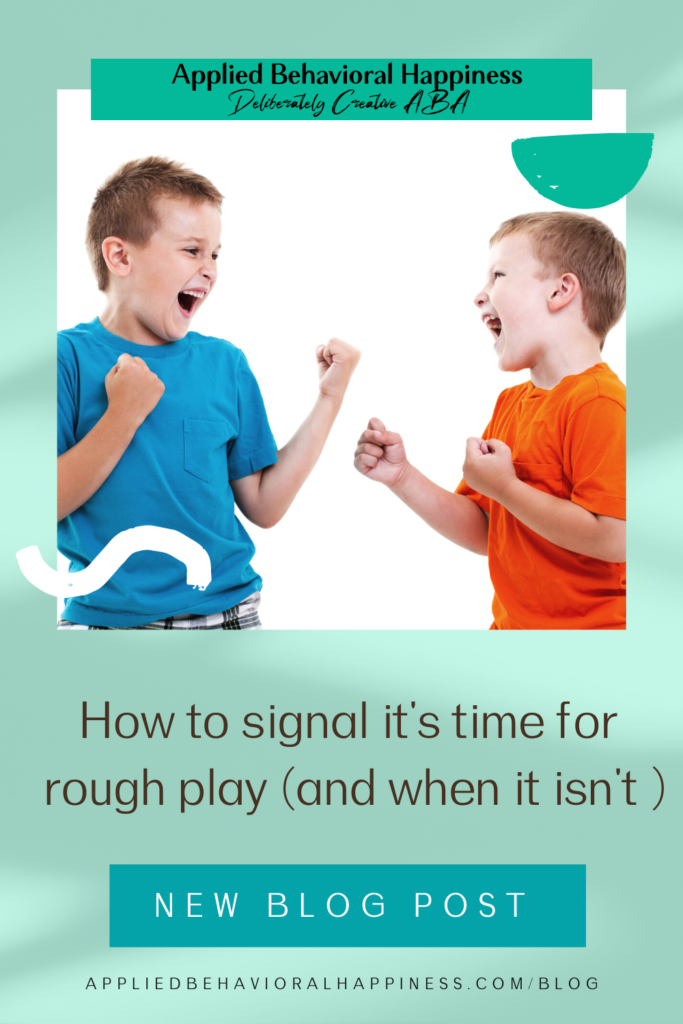How does your child know that it’s time to wrestle? Do they know when it’s time to stop? When it’s a bad time to initiate the people’s elbow (shout-out to The Rock in his WWE days!) or when it will be greeted with applause? That’s our focus today! This is how you signal that it’s time for rough play and how to make sure it’s respected when it isn’t. Let’s dive in!
What do you mean by rough play?
Rough play can mean any or all of the following, can mean something totally different for your family than for another family, and may be dependent on context (e.g., what’s rough at a tea party may not be rough in a wrestling class which may be different than rough in a dodgeball match) or who you are with (rough with little siblings may be different than rough with uncles).
- Wrestling
- Play aggression or play fighting (kicking hitting, sword fighting, pelting, etc.)
- Climbing on others
- Pushing others playfully
- Using your body to contact another body with force
Why would you want to signal that it’s time for rough play and when it isn’t?
Remember those contexts and people we talked about above? Those are two good reasons to make sure your kids know when (and with whom) they can play rough. While you can tackle your neighbor on the couch, you can’t tackle a toddler on the sidewalk.
There is also the magical, mystical transition time: that time between “We are playing and this is fun” and “We are done playing and that will no longer be well received.” If you don’t have a signal ready to rock, that ambiguity may lead to some misunderstandings.
The last really big reason is when someone who is usually up for rough and tumble is in a place or context that is usually accepting of such behavior, but something is different this time. Maybe it’s someone else’s turn to show off their Taekwondo skills and test for a new belt (“It’s not your turn, please sit back down”). It can be that a person who is often up for rough play has an injury or recent surgery and can’t engage like they normally do. A surprise tackle could be devastating to both their health and to your child’s confidence. After all, no one likes to accidentally hurt someone else.
Having a clear signal around rough play can save you and your child from a lot of unnecessary pain!
1) rough play: talk about consent and context
Des your child know that throwing kicks is super cool and extremely acceptable in karate class? Talk about it! I am a huge proponent of martial arts for kids, and there is so much good that can come of it including talking about consent and context.
When you are around people who are willing to play rough, talk about how to make sure that you have consent to play rough. For example, this can mean asking them if they want to wrestle before tackling them. It can mean knowing how to tell it’s your turn to practice punches and blocks in class. It can mean listening for signs of consent being revoked, such as a person tapping out, saying “ouch”, or asking you to stop — and respecting this request!
Martial arts studios and gyms are great because they provide clear context for rougher types of play. Pulling out all of the cushions from the couch may be your signal that is wrestling time at home. These signals that the context is right are helpful for kids to learn and understand because they will help them read more complex situations in the future.

2) Rough play signal: create a clear on or off signal
I had an awesome conversation with an amazing mom at the Mom’s Event a few months ago. Her kids love rough play and it is great for their development, but sometimes their timing was well… bad. She couldn’t wrestle and make dinner, for example. Or if things got too rough, they didn’t know how to stop and calm down. I advised that she create an on or off signal.
An on signal looks like an open sign, showing that you are ready to go. I often suggest a rough play jersey for parents who have kids that are trying to engage with them at inappropriate times. When you are wearing the jersey, you are saying “I am available and ready to play rough! Bring it on!” When you are not wearing the jersey, you simply will decline attempts to play rough. By explaining this simple signal to your child, you can stop the sneak attacks and have a wonderful and open conversation about body autonomy and consent.
An off signal looks like a construction detour sign: it’s temporary and lets you know that this is not available right now. I will sometimes suggest something like a snap away bracelet that can be pulled off to signal that the game must stop. This can be paired with verbal cues and instructions (“I’m all done wrestling”, “Stop please”) and faded with time.
3) rough play signal: practice, talk about it, and practice more
The more you talk about it, the better off you will be. These skills will lead into your child’s ability to provide and respect consent later in life, which is an often undervalued skill in young kids. Helping your child regulate and respect the bodies of others is a beautiful thing and signals can help you achieve just that.
